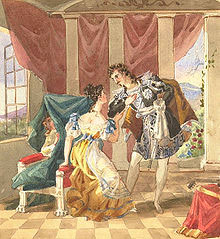Le nozze di Figaro: Mozart’s operatic gem comes to Opéra de Montréal by Joseph K. So
/ September 1, 2011
Version française...
Flash version here
 Mozart’s opera buffa Le nozze di
Figaro was composed in 1786, with a libretto by Lorenzo Da Ponte
based on a play by Pierre Beaumarchais. Two hundred and twenty-five
years later, it remains one of the most popular operas of all time.
According to operabase.com, during the last five seasons (2005-2006
to 2009-2010), Nozze was the fifth most popular opera in the
world with a total of 399 professional performances. Only Die Zauberflöte
(451), La traviata (447), Carmen (424), and La bohème
(420) were performed more frequently. Mozart’s opera buffa Le nozze di
Figaro was composed in 1786, with a libretto by Lorenzo Da Ponte
based on a play by Pierre Beaumarchais. Two hundred and twenty-five
years later, it remains one of the most popular operas of all time.
According to operabase.com, during the last five seasons (2005-2006
to 2009-2010), Nozze was the fifth most popular opera in the
world with a total of 399 professional performances. Only Die Zauberflöte
(451), La traviata (447), Carmen (424), and La bohème
(420) were performed more frequently.
Mozart thus claims two of the top five
spots in this unofficial popularity contest. Without the Masonic symbolism
and deep philosophies in Die Zauberflöte, Nozze
is the most human of Mozart's operas. A comic-dramatic plot dealing
with love, lust, jealousy, infidelity, and ultimately forgiveness never
goes out of style, especially when framed by a divine score full of
scintillating arias, duets, and ensembles.
Just beneath the surface of Nozze
is Mozart’s social commentary—rather daring in his time—on the
tension between two worlds separated by class and wealth: the “upstairs”
domain of the aristocratic Count and Countess, and the “downstairs”
world inhabited by “the common folks,” the working class Susanna
and Figaro. There are no gods and goddesses, just people of flesh and
blood, whose lives remain as fresh and relevant today as in Mozart’s
time.
Nozze premiered to moderately
positive reception in Vienna in May 1786, with Mozart himself conducting.
It was staged in Prague later the same year to solid success. Figaro
and Count Almaviva are sung by baritones, although in Mozart’s time,
the baritone voice category did not exist. Similarly, Cherubino,
normally assigned to a mezzo today, was classified as a soprano.
This being one of the more lengthy Mozart
operas with four acts and three hours of music, Nozze is often
performed with a number of “standard cuts”: Marcellina and Basilio’s
arias in act 4, plus a duet, chorus repeats, and various cuts to the
recitatives. Mozart also recycled some of the music in other works—Figaro’s
aria “Non più andrai” has an instrumental quotation in act 2 of
Don Giovanni, and the Countess’s aria “Dove sono” has its
origin in the Agnus Dei section of his Coronation Mass.
The principals in Nozze (Figaro,
Susanna, the Count and Countess) are very exacting roles that demand
Mozart singers of the first order. For example, the act 2 opening aria
of the Countess, “Porgi amor” has to be sung “cold” with no
chance for the soprano to warm up. It requires long breath, accurate
intonation, purity of sound, and rock-solid legato, an acid test
for any singer. Similarly, the Count’s bravura aria “Hai gia vinta
la causa…Vedro mentr’io sospiro” requires a free upper register
combined with a powerful sense of drama. Generally considered the prima
donna in Nozze, Susanna has only one aria, “Deh vieni non tartar,”
and the tessitura is unremarkable, but it’s a role requiring real
stamina as Susanna has lots of ensemble work and is on stage for most
of the opera. Modern-day directors seem to prefer youthful singers for
Figaro and Susanna as these are as much acting as singing roles, and
good chemistry between them is vital.
L’Opéra de Montréal has assembled
an ideal cast. Top on my list is baritone Phillip Addis as the Count.
Addis, with his spectacular lyric baritone and powerful stage persona
is tailor-made for this role. He partners the American soprano Nicole
Cabell as the Countess. Winner of the 2005 Cardiff Singer of the World
Competition, Cabell is sure to light up the stage with her luscious
soprano and alluring stage presence. Robert Gleadow has previously sung
Figaro with the COC. His irrepressible personality is a real asset as
Figaro. Hélène Guilmette sings Susanna.
Le nozze de Figaro, Opéra de
Montréal, September 17, 20, 22, 24, 19:30, Salle Wilfrid-Pelletier
operademontreal.com
|
» Discography
| |
One of the most recorded of Mozart's
operas, there are plenty of great recordings of Nozze.
Several came out around the mid-1950s to coincide with the Mozart bicentenary.
Erich Kleiber’s on the Decca label (1955) has the great Cesare Siepi
and Hilde Gueden as Figaro and Susanna. Also indispensable is Giulini
on EMI (1959) with Schwarzkopf (Countess) in one of her signature roles
and Anna Moffo as a surprisingly effective Susanna, partnered by Giuseppe
Taddei as an idiomatic Figaro. Also worthy is the Colin Davis recording
from 1970 on Philips, with Mirella Freni a gorgeous-voiced Susanna and
Jessye Norman an opulent Countess.
On video, one of the most enjoyable is
the 1975 performance conducted by Karl Böhm and filmed by Jean-Pierre
Ponnelle. It has a “dream cast”—the adorable Susanna of Freni,
here paired with the slightly mature but honey-toned Figaro of Hermann
Prey. A very young Kiri Te Kanawa is a fresh-voiced Countess.
Captured for posterity is the great Dietrich Fischer-Dieskau as the
Count. The American mezzo Maria Ewing is an intriguing Cherubino, captured
here before her vocal decline. Of the several recent productions, a
standout is the 2001 René Jacobs version with Simon Keenlyside as the
Count and Veronique Gens as Countess. Also enjoyable is the 2006 Mozart
year production from Salzburg on CD and DVD. It has the glamorous Anna
Netrebko as Susanna, a role she has since dropped.
|
Version française... |
|


